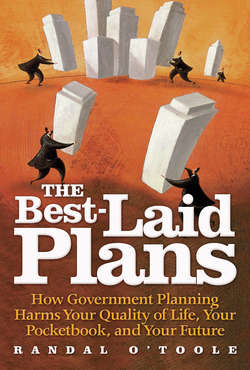Читать книгу The Best-Laid Plans - Randal O'Toole - Страница 12
На сайте Литреса книга снята с продажи.
Below-Cost Timber Sales
ОглавлениеIn the 1950s, the Forest Service claimed, with some justification, that it was the only federal agency that earned a profit. It continued to make this claim through the 1970s, but by this time it was spending hundreds of millions of dollars more to manage the national forests than it returned to the Treasury.
Moreover, as Natural Resources Defense Council analyst Tom Barlow found when he compared timber receipts with timber-related costs, most national forests lost money on their timber sales alone, not counting the costs of recreation, wildlife, and other resource management.3 Barlow coined the term below-cost timber sales and inspired Congress to include a requirement in the National Forest Management Act that forest plans identify lands “not suited for timber production, considering physical, economic, and other pertinent factors” and exclude those lands from timber management.
Whatever Congress’s intent, the effect of the Knutson-Vandenberg Act was to reward forest managers for losing money on timber sales. I once asked a timber staff officer how long the Forest Service had to revise K-V plans after a sale was completed. “The plan can be revised until the sale is closed,” he said, meaning when the last trees were cut and the last dollars paid for the sale. “And if you want to do it, you had better do it by then or the money is lost—it goes to the U.S. Treasury.” Two decades of timber sales transmogrified an agency that had been proud to return more money to the Treasury than it spent into an agency that viewed returns to the Treasury as “losses.”
The Knutson-Vandenberg Act authorized the Forest Service to collect money for reforestation and other activities “in addition to the payments for the timber.” Up until 1956, that’s what the Forest Service did: purchasers paid for K-V activities separately from their payment for timber. Starting in 1957, however, K-V funds were simply incorporated into the total payment for timber. At this time, the Forest Service required managers to return only 50 cents per thousand board feet to the Treasury.
This number was selected because, at some point in the remote past—presumably soon after Congress passed the Knutson-Vandenberg Act in 1930—50 cents per thousand represented the cost to the Treasury of arranging and administering timber sales. But by the 1970s, this cost was approaching $15 per thousand. Although timber purchasers usually built the roads, the cost of designing the roads was paid with tax dollars, and it could more than double sale costs. But the Forest Service never changed the 50-cent rule, and it remains in effect to this day.4
Timber values in many national forests were so low that forest managers would keep nearly all timber receipts in the K-V fund to pay for reforestation and other activities. The sale would be below cost because the 50 cents returned to the Treasury failed to cover the $15 to $30 cost of arranging the sales and engineering the roads.
Other forests had at least some timber that could earn a profit. But these forests became adept at cross-subsidizing timber, that is, designing timber sales to include both valuable timber and worthless timber elsewhere on the same forest. The purchaser would pay less for the valuable timber than it was really worth in exchange for also removing worthless timber.5
For example, suppose a forest had a stand with a million board feet of valuable ponderosa pine trees worth $60 per thousand board feet. The reforestation specialist says that reforesting the site would cost $9,500, including administrative overhead. Selling the trees for $60,000 would allow the forest to keep $9.50 per thousand board feet for reforestation and the remaining $50.50 would go to the Treasury. Elsewhere, the same national forest has a stand of a million board feet of low-value lodgepole pine trees worth negative $40 per thousand board feet—that is, the cost of cutting and transporting the trees to a sawmill would be $40 less than the mill would pay for the logs. If it can sell the trees, the Forest Service could spend more money on reforestation and, of course, have more money for administrative overhead. To sell the lodgepole pine, the forest combines both stands in the same sale. It sells the trees for $10 a thousand board feet, or $20,000. Costs to the Treasury double but receipts to the Treasury fall from $50,500 to just $1,000. Meanwhile, the Forest Service doubles its K-V collection to $19,000.
Such cross-subsidization was extremely common in the national forests. In 1984, I analyzed every timber sale sold by the Forest Service in 1983—roughly 10,000 of them. I was surprised to discover that the forests with the most valuable timber did the most cross-subsidization. The reason was simple: timber values in some areas were so great that managers could not possibly spend all of the receipts within a quarter mile of the timber cutting. Rather than return the maximum amount to the Treasury, forest managers “spent” some of that timber value subsidizing the cutting of other worthless trees on the same forests.6 Timber purchasers went along with the game, but were known to call the worthless areas “punishment units” because the losses they took on those units were their punishment for getting other valuable timber at such low prices.
